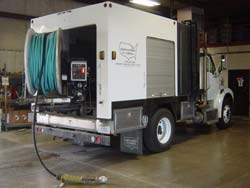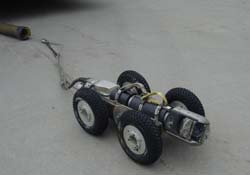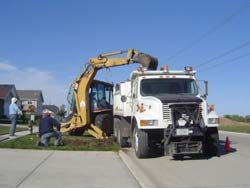Cleaning of the pipelines is necessary to prevent stoppages from happening. A stoppage occurs when the pipe becomes clogged, and wastewater can no longer flow and starts to back up within the pipe. This backing up of wastewater could lead to a Sanitary Sewer Overflow (SSO). An SSO is defined as any overflow release, discharge, or diversion of untreated or partially treated wastewater from a sanitary sewer system. The two most common SSOs are basement backups and wastewater discharges from manholes.
Stoppages are caused by a variety of factors: debris; fat, oil and grease (FOGs); tree roots; and paper products. These factors intermingle within the pipelines and start sticking together to create a mass that can eventually become the full diameter of the pipe and causes it to clog. The City works very hard to keep this from happening as part of the Collection System Maintenance Program.
To help prevent stoppages the City uses "jet trucks" (see picture) to provide maintenance cleaning of the sanitary sewer system. Two manholes are opened on either end of the pipe segment to be cleaned. On the downstream end the jet nozzle is lowered into the bottom of the manhole. It is connected to the truck by a long, high pressure hose. The water pressure is turned on and the jet nozzle is propelled up the line, against the flow of water, until it reaches the upstream manhole. Then the nozzle is brought slowly backward while spraying a jet of water onto the interior walls of the pipe. This water knocks down debris, grease, some roots and cleans the inside of the pipe smooth again. The cleaned pipe is now free flowing and at full capacity once again. Most pipes are cleaned once every three years. Some pipes are cleaned as often as every three months.
 (JPG, 72KB)
High Pressure Sanitary Sewer Cleaning Equipment – Called a Jet truck
(JPG, 72KB)
High Pressure Sanitary Sewer Cleaning Equipment – Called a Jet truck
Another maintenance effort involves the removal of tree roots from sanitary sewers. Tree roots can be a real menace, damaging sewers, catching debris and causing sewers to clog. Tree roots seek the moisture and nutrients offered by leaky pipe joints and service connections. Tree roots are most often found in vitrified clay pipes, which are often in parts of town built before 1980.
There are two ways to control the growth of roots within the collection system: mechanical cutting or herbicide application. Mechanical cutting involves attaching a cutting blade to the jet nozzle, which will spin inside of the pipe to cut the roots off. While this method is effective in removing the roots it does not keep them from growing back. The EPA approved herbicide method involves filling a pipe segment up with a foam the consistency of shaving cream. This foam does two things: 1) it kills the roots by contact, and 2) it stays adhered to the pipe walls and inhibits future root growth for a period of time. Neither of these methods cause damage to the trees above nor do they interfere with the water resource recovery process.
 (JPG, 120KB)
Root cutting blade
(JPG, 120KB)
Root cutting blade
One of the critical components of the preventative maintenance program involves internal inspection of sanitary sewers using a T.V. camera. The camera has a rotating head, lights, and zoom functions which allows 360 degrees of viewing of the pipe interior. The camera is attached to a crawler which is remotely controlled. The camera is set in the upstream manhole and then moves down the pipeline along with the flow. There is a video cable attached to the crawler and camera providing power, control and video feed back to the TV van. The camera head is turned to view service connections and any defects found, which are then recorded and put into an asset management system. This information is then used to determine the conditional rating of that pipe segment and if immediate repairs are required or not. The video information is also used to determine the effectiveness of the pipeline cleaning and root control maintenance activities. New sanitary sewers are also inspected to make sure they were installed per plan and City specifications. The City's goal is to video inspect each pipe on a 12 year or less interval.
 (JPG, 25KB)
Sanitary Sewer Internal T.V. Inspection Camera
(JPG, 25KB)
Sanitary Sewer Internal T.V. Inspection Camera
The Collection section staff self-performs some sanitary sewer line and manhole repairs. City staff usually performs repairs on lines and manholes that are found to be in critical condition with signs of imminent failure. Other repairs are grouped together, bid out, and performed by contractors.
Types of pipeline repairs and rehabilitation
- Point Repairs – When less than a 5' section of pipeline needs to be replaced.
- Pipe Line Replacement – When a greater than 5’ section needs replacement, has is a low spot in the line, or when the line needs to be moved to an alternate location. This type of repair uses an open trench excavation method of construction.
- Pipe Bursting – When the entire line needs replaced, but the location and grade are still good. This method displaces the old pipe with a new pipe and requires only minor excavations.
- Cured in Place Pipe Lining – This method inserts a new pipe lining into the old pipe to increase structural strength and seal up any cracks and holes.
- Spot lining – This method inserts a new lining into an old pipe but only covers a 2-4' section
The City repairs and rehabilitates over 12,000 feet of pipeline yearly. The budgeting for the repairs can be seen in Wastewater's Capital Improvement Program (CIP) under the line item Selected Replacement. These CIP projects are reviewed and approved by the Lincoln City Council.
 (JPG, 24KB)
Sanitary Sewer Maintenance
(JPG, 24KB)
Sanitary Sewer Maintenance
Infiltration/Inflow (I/I) is extraneous water that enters the sanitary sewer system. Inflow is water that is intentionally and illegally put into the collection system by sump pump connections, roof drains or foundation drains. Infiltration is water that enters through cracks or leaky joints. An important ongoing task is to locate and remove these sources of I/I. Excessive I/I can overload the sewer system, cause basement flooding and overload the recovery facilities, which occurred during the 100-year storm events in October 2014 and May 2015. The quantity of wastewater inside of the collection system was five times the normal rate during those storms. The City is working on developing additional programs to mitigate I/I sources.